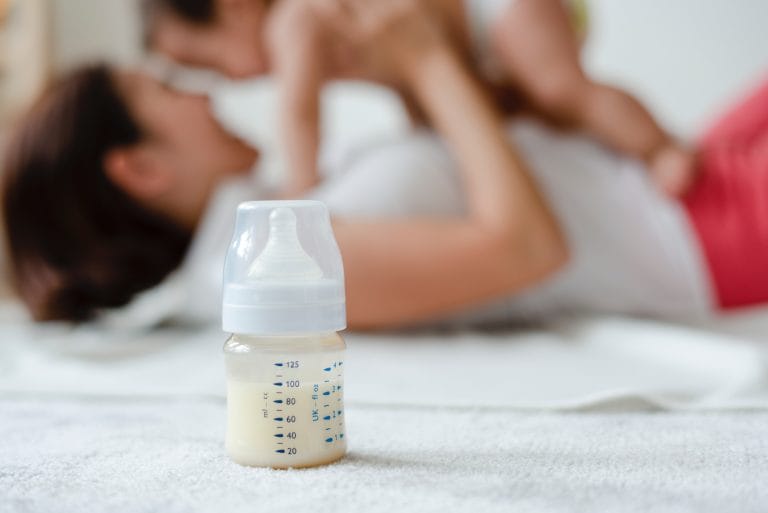Routines during a baby’s early years are very volatile. You will find yourself making changes quite often. One example of this is when parents switch from formula to milk.
For some parents these changes are smooth, but for some they can be quite hard. In this article, I will guide you through the following:
- When you can switch from formula to milk
- How to switch from formula to milk
- How much milk your baby should drink per day
- Whether you should use a bottle or sippy cup for the transition
Please note, there are affiliate links in this post. Read my privacy & disclosure policy at the bottom of this page to learn more.
When Can You Switch Your Baby From Formula To Cow’s Milk?
The ideal age for a baby to switch from formula to cow’s milk is 1-year-old. Before this age, babies should drink formula or breast milk.
You can introduce cow’s milk later than 1 year old, but not earlier. The nutrients in cow’s milk are not suitable for a child less than 1 year of age. It is a great source of proteins and minerals, but your little one’s kidneys cannot handle them.
What Kind Of Milk Should I Switch My 1-Year-Old To?
You should switch your 1-year-old to whole cow’s milk. Whole milk contains the nutrients and enough fat for your little one.
Do not use low-fat milk options, as your toddler needs extra fat for appropriate brain development. If your little one was put on a hypoallergenic or soy-based formula, you should consider talking to your child’s pediatrician first before switching to any milk.
What If My Toddler Can’t Have Whole Cow’s Milk?
If your toddler can’t have whole cow’s milk due to an allergy or some other reason, you can choose fortified soy milk as an alternative.
According to cdc.gov, “Fortified soy beverages are the only milk alternative that helps meet a child’s recommended dairy needs. Choose one that is unflavored and unsweetened. Your child does not need added sugars. The soy milk should be fortified with vitamin D and calcium.”
How To Switch From Formula To Milk – Step By Step
Switching away from formula should be gradual. If you change over to whole cow’s milk all at once, your child may not accept it.
And even if he does, it may upset his stomach. So, a gradual approach is best. Here’s how to switch from formula to milk step-by-step.
Step 1- Start Using a Little Cow’s Milk in Food
Before introducing cow’s milk as a replacement for formula, it is best to introduce it in a food. For example, you could put a little whole milk in your baby’s oatmeal.
Use a smaller quantity at first and see how your little one’s stomach responds to this slight change. If your toddler is fine with it, continue the transition. If his stomach becomes upset or he gets an allergic reaction, talk to the doctor before moving on.
Step 2- Gradually Mix Cow’s Milk With Formula In The Bottle
If everything goes well and your toddler is ready to switch from formula to milk, start adding a small amount of whole milk to your baby’s bottle of formula.
I would start with 25% whole milk and 75% formula. After 2-3 days gradually increase the amount of added cow’s milk, while also reducing the amount formula in the bottle.
Remember, this transition should be very gradual as formula milk is sweeter than cow’s milk. If you add too much cow’s milk at once, your child will likely reject it.
Step 3 – Stop Using Formula Altogether
When you are sure that your toddler’s tummy is fine with cow’s milk and he is accepting the taste, you can stop adding formula altogether.
Step 4 – Try Adding Flavor (If Needed)
As mentioned earlier, cow’s milk is not as sweet as formula milk. This can make it hard for kids to accept this new “dull” and “boring” flavor.
If your toddler is not very accepting of cow’s milk you can try adding fruit. A good example for this is a banana, which will give a sweeter taste to milk.

Should I Use a Bottle or Sippy Cup When Switching From Formula To Milk?
When you are switching from formula to milk, do not try to also change your feeding method. Use the same device you have been using for formula for now.
Whether it’s been a bottle or sippy cup – continue using it. It can be stressful for your little one if you try to switch both the milk type and the bottle at the same time.
If you wish to serve cow’s milk in a sippy cup, I recommend transitioning to cow’s milk first. And after at least a week or more you can start the bottle to sippy cup transition.
How To Introduce a Toddler To a Sippy Cup
- At first, introduce a sippy cup for only drinking water. This can happen as early as 6 months old.
- Use a sippy cup that mimics the bottle. For example, I personally had great success with the NUK Learner Cup for all 3 of my children.
- Once your toddler accepts the sippy cup AND has transitioned to whole cow’s milk, it’s time to get rid of the bottle.
- Start by putting milk in the sippy cup and see if your child is willing to drink milk from it, since he already drinks water from it.
- If you run into problems you can apply some aloe vera gel on the bottle nipple. This has a bitter taste and might make your toddler reject the bottle. Be ready to pour the milk from the bottle into the sippy cup and then give it again.
- Once your toddler takes milk in a sippy cup, don’t offer a bottle again.
How Much Milk Should My Baby Drink Per Day?
The recommended amount of milk a child should consume changes with age. A child less than one-year-old will be consuming milk as a main source of nutrition. After that, he will consume more solid food as the main nutritional source, reducing the recommended quantity of milk consumed.
At 1 year old (when you switch from formula to cow’s milk), expect your toddler to be consuming approximately 20 ounces of milk per day. By comparison, at 6 months old your baby will likely consume 7 ounces of formula or breast milk 4-5 times a day. That’s 28-35 ounces of milk per day, which is a pretty big difference.
Is Whole Milk The Equivalent Of a Meal Like Formula Is?
For a toddler, whole milk is not equivalent to a meal. A 1-year-old needs other nutrients from solid food too.
Whole milk contains proteins, fats, carbohydrates, and sugar. It does not contain dietary fiber, which a toddler needs 19 grams of per day.
Whole milk also contains a negligible amount of iron. A toddler in the age range of 1-3 years old needs 7 mg of iron daily.
Essentially your toddler requires many other nutrients that are unavailable in milk. This means whole milk is not equivalent to a meal, unlike formula which is a meal for a child younger than 1-year-old.
When Can I Switch To Low-Fat Milk?
Toddlers between 1 and 2 years old need whole milk “fat” for optimum brain development. After that you can safely switch to low-fat or skim milk.
According to the American Association of Pediatrics though, if a child is at a high risk for obesity or heart disease you can switch to non-fat milk earlier. You should consult your child’s doctor to determine whether or not your child is high risk.
Usually if obesity or heart disease run in the family, a child may be at a higher risk of these diseases.
Am I Supposed To Use Toddler Formula When Switching To Milk?
It is not necessary to use toddler formula when switching from formula to milk. Toddler formula is designed for low-weight toddlers or those who are at risk of nutritional deficiencies.
Toddlers that are picky eaters might also use toddler formula. The main purpose of toddler formula is to provide the nutrients that are usually unavailable in cow’s milk (or any other milk).
This formula should be given only to toddlers who are not eating enough or need more nutrients to grow up healthy. Consult with your pediatrician for more advice on toddler formula.
I hope switching from formula to milk is an easy transition for you. Following the steps above will definitely help.
Some kids are highly adaptable and will quickly accept a new taste. However, many kids will not.
You should consider switching from formula to whole cow’s milk when your little one is 1 year old. Then you can switch to low-fat or skim milk when he is over 2 years old.
The best approach is a gradual transition. Start with adding a little cow’s milk in meal preparation or in a snack. See how your little one’s stomach responds to it.
If everything is fine, mix a small amount of cow’s milk with regular baby formula. Gradually increase the quantity of cow’s milk and reduce the formula. Continue until your toddler is fine with the new taste. Then you can skip the formula altogether.
After the transition to cow’s milk is 100% complete, you can consider introducing milk in a sippy cup. I wish you the best of luck with the transition.






